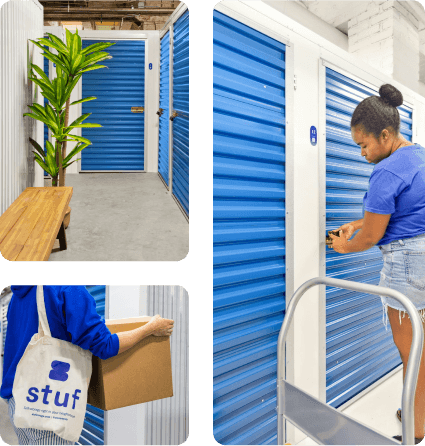When your apartment’s starting to feel more like a shipping container than a home office or your side hustle inventory is spilling into the kitchen, you know it’s time for a storage unit. But then comes the inevitable question:
Do I really need climate-controlled storage, or is regular storage good enough?
At first glance, it might seem like a fancy upsell. But when temperatures swing from freezing to blazing, or humidity creeps in undetected, the wrong choice can ruin everything from leather sofas to laptops to grandma’s old photo albums. But then again, not all your items going into storage need special treatment. So, in this guide, we’ll shed light on how climate-controlled vs non-climate-controlled storage units compare and how to find the best storage facilities for your needs. Learn more about these strategies below.
What’s the Difference: Climate-Controlled vs Non-Climate-Controlled Storage Units?
At a glance, most storage units look the same with four walls, a ceiling, and a secure door. But behind the scenes, there’s a critical distinction that could make or break the condition of your belongings over time: climate control.
What is climate-controlled storage Climate-controlled storage units are typically located inside a building and are equipped with HVAC systems that regulate temperature and often humidity as well. This creates a stable environment year-round, regardless of outdoor weather conditions, for temperature-sensitive items like electronics, furniture, and musical instruments.
But it’s important to clarify that not all climate-controlled storage units include true humidity control. Some only manage temperature, so be sure to ask your facility what exactly is being regulated.
What are non-climate-controlled personal storage units?
These are your standard, drive-up units, often located outdoors with garage-style doors. They’re exposed to the same temperature shifts, moisture levels, and seasonal changes as the local environment. And while they typically offer good ventilation, they don’t actively regulate heat, cold, or humidity.
For some items, that’s not a problem. For others, it’s a recipe for deterioration.
Here is a more comprehensive comparison of the two storage unit types:
Climate Controlled vs. Non-Climate Controlled Storage Units
| Feature |
Climate Controlled
|
Non-Climate Controlled
|
|---|---|---|
| Temperature Range | Consistently maintained between 55°F – 85°F (13°C – 29°C) |
Matches outdoor temperature swings. Temperatures can range from sub-zero to 100°F+ |
| Humidity Control | Often includes humidity regulation |
No active humidity control. It may be affected by seasonal moisture. |
| Protection from Environmental Factors |
High: Sealed indoor environment shields against dust, pollutants, and pests | Low: Susceptible to weather-related intrusion |
| Air Quality | Filtered, ventilated indoor air allows a lower risk of mold, mildew, or stale smells | Unfiltered outdoor air means it's more vulnerable to condensation, mold, and mildew |
| Security Access Point | Generally, inside a secure building with a passcode or app entry | Usually external drive-up access with padlock or gate-level security |
| Location Within Facility |
Located in multi-story or enclosed buildings | Typically ground-level, exterior-facing garage-style units |
| Ventilation | Mechanical air circulation ensures consistent airflow | Passive or minimal ventilation, depending on unit construction |
| Pest Control | Lower risk due to indoor setting and sealed structure | Higher risk of pests like rodents and insects, especially in ground-level units |
What Belongs in a Climate-Controlled Storage Unit (And What Doesn’t)
Many items in your home can be sensitive to climate and humidity, and failing to store them properly can lead to costly, sometimes irreversible damage. Use this guide to know what requires extra protection and what can survive just fine in a standard unit.
Items that need climate-control

- Wooden Furniture
– Sensitive to temperature and humidity swings– Can warp, crack, or split over time -
Electronics (TVs, computers, audio equipment)
– Prone to corrosion from condensation
– Extreme heat or cold can permanently damage internal components
- Generally, it’s recommended to store electronics in temps between 0°C and 45°C (32°F to 113°F), however, it can vary between manufacturers.
– If you’re unsure of which temperature to store your items, check your electronics
guidebook or manufacturer guidelines online.
-
Books, Documents, and Photos
– Paper can yellow, become brittle, or grow mold in humid conditions. I recommend not folding these in any way to prevent permanent marks. It’s also best to scan them and have digital copies. – Ink may fade or bleed
– They’re best kept in conditions are between 15-21°C (60-70°F) and a relative humidity of 30-50%.
-
Artwork & Collectibles
– Easily affected by heat, UV light, and moisture
– Mixed materials (e.g. canvas, metal) react differently to climate stress
– Professional art storage services maintain environments between 65–70°F and ~50% humidity, which can be achieved in climate-controlled storage units
-
Musical Instruments (woodwinds, guitars, violins)
– Wood expands and contracts with humidity
– Strings and adhesives can loosen or degrade
-
Leather and Upholstered Furniture
– Vulnerable to mold, mildew, and cracking>
– Fabric can discolor or deteriorate
– Before storing your leather, I recommend applying a leather conditioner and letting it completely dry before storing. Also, place them in breathable cotton bags rather than plastic garment bags to prevent moisture buildup.
-
Vinyl Records, Wine, Cosmetics, or Medical Supplies
– React poorly to high heat or cold
– May lose quality, melt, or become unusable
Items that do well in non-climate controlled storage units
Some items are tough enough to handle heat, cold, or moisture without a problem, especially for short-term storage (less than 3 months):
- Plastic furniture or bins
– Unaffected by humidity or temperature shifts - Tools and Hardware
– Built for outdoor use. Just ensure they’re dry before storing - Yard Equipment & Outdoor Gear (bikes, tents, snowboards)
– Designed to withstand a wide range of conditions - Holiday Decorations (non-fragile or plastic-based)
– Can typically handle storage fluctuations - Metal appliances (when cleaned and dried)
– Just be sure to defrost and drain before storing to avoid moisture build-up
Key Factors That Should Guide Your Decision
Whether climate control is necessary or just nice to have depends on a few core factors:
1. Geographic location and climate
Where you live has a direct impact on how well your stored items will hold up. For instance, if you live in cities like Houston, Miami, and New Orleans where average relative humidity levels can be above 75%, a non-climate-controlled unit may not offer enough protection for temperature-sensitive or moisture-sensitive items.
Why?
- High humidity (typically above 60%) provides the perfect conditions for mold, mildew, rust, and warping. Moisture in the air seeps into materials like wood, leather, paper, and electronics, causing them to degrade, often silently, until you open the unit months later and discover the damage.
- Extreme temperatures, such as summer highs over 90°F or winter lows below freezing, can cause
materials to expand and contract, leading to cracks, warping, and failure of adhesives, seals, or mechanical components.
Remember, if you wouldn’t leave it in your garage year-round, you probably shouldn’t leave it in a non-climate-controlled storage unit.
2. Length of storage time
The longer you store something, the more time environmental factors have to cause harm. Short-term storage (under 1–2 months) in a standard, non-climate-controlled unit may be sufficient for durable household items like metal tools, plastic bins, or lawn equipment. But if you're planning to store furniture.
Long-term exposure to moisture and heat speeds up chemical degradation, encourages microbial growth, and shortens the lifespan of materials in certain items.
3. Local weather conditions
Even beyond temperature and humidity, weather events like storms, floods, or snow can affect storage integrity, especially in non-climate-controlled, drive-up units.
- Heavy rain can lead to water intrusion if your unit isn’t properly sealed or elevated.
- Snow and ice buildup around outdoor units can cause freezing at the door seams or water ingress during thaws.
- Storms and hurricanes increase the likelihood of wind-driven debris, pest intrusion, and even power outages that impact HVAC systems in poorly maintained facilities.
4. Cost
On average, climate-controlled storage rates cost 20% to 50% more than their non-climate-controlled counterparts of the same size. This variance depends on:
- Facility location (urban vs. suburban)
- Indoor vs. outdoor unit
- Type of climate system (HVAC vs. passive ventilation)
- Facility amenities and security
Which Unit Type Is Right for You? Making the Final Call

- You need consistent internal air quality year-round. Beyond temperature and humidity, climate-controlled facilities often use HVAC systems with air filtration, helping reduce dust, mold spores, and allergens that can degrade sensitive materials over time.
Filtered air circulation is especially valuable for those storing paper archives, leather goods, or allergy-prone fabrics like wool. -
Your unit will double as a touchpoint for your work or lifestyle.
Using the unit regularly to access business inventory, manage seasonal wardrobe swaps, or store creative tools? Climate-controlled units offer cleaner, more stable environments that make repeat visits safer and more productive. -
You're splitting storage responsibilities with someone else.
When co-sharing a space, for example, with roommates, family, or business partners, it’s safer to choose climate control to protect all parties’ belongings equally, especially if their sensitivity varies.
-
You have limited time or resources to prepare your items.
Non-climate storage often requires careful sealing, insulation, and protective packaging. Climate-controlled storage lets you skip most of that extra prep and still maintain item integrity.
-
You have control over your storage prep and can protect items yourself.
If you’re committed to using vapor barriers, desiccants, and durable plastic bins, you may not need the added protection of climate control.
-
You’re using your unit primarily for logistical convenience, not preservation.
Need to free up garage space? Storing project materials or moving overflow? Non-climate storage works well when the primary goal is decluttering, not long-term preservation -
You plan to rotate items in and out often.
When items spend only a short stint in storage, like event supplies, seasonal tools, or staging furniture, short-term use minimizes the risks associated with unregulated environments -
You’re storing items that have already endured outdoor use.
Items that live in sheds, garages, or attics (like power tools, camping gear, or plastic deck furniture) typically fare just fine in non-climate units, since they’ve already been tested by the elements.
Find the Best Storage Facilities That Work For You
Storage is where your things wait, adapt, and endure. So instead of treating your personal storage unit like an afterthought, think of it as an extension of how you live, work, and protect what matters.
At the end of the day, the best storage facilities aren’t defined by features alone. They’re defined by how well they fit into your life without disrupting it.
If you’re still unsure, look for storage providers that make decision-making easier with transparent descriptions, digital booking tools, and flexible unit types like Stuf Storage. With city-based locations and a tech-forward approach, you can rest assured that your things are in safe hands.









